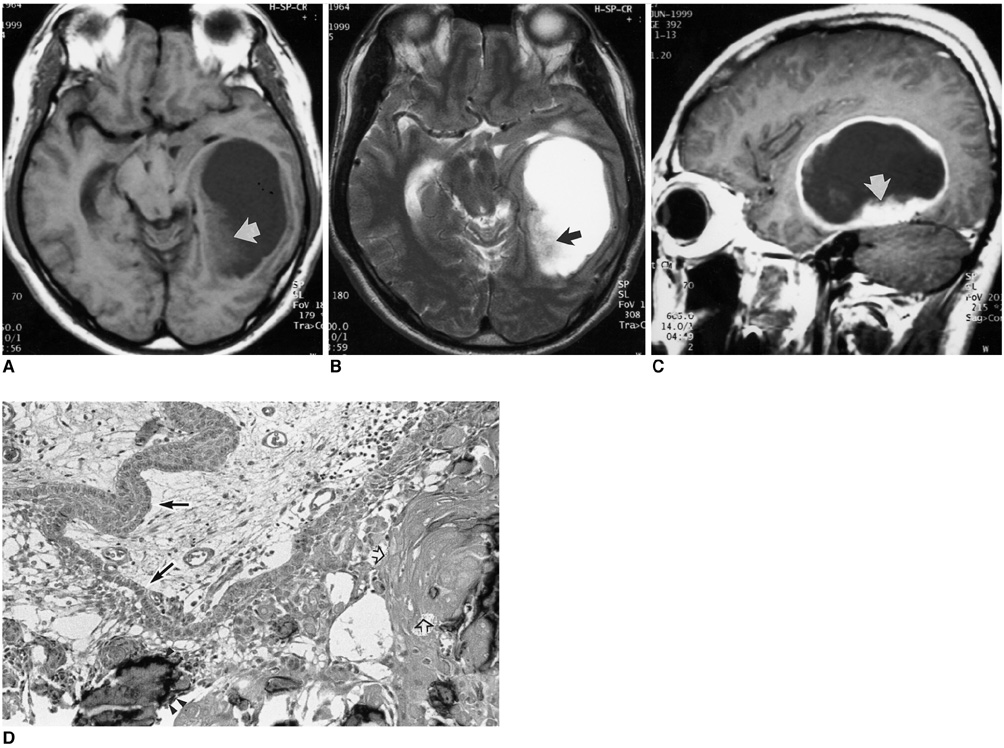Korean J Radiol.
2004 Mar;5(1):72-74. 10.3348/kjr.2004.5.1.72.
Craniopharyngioma in the Temporal Lobe: A Case Report
- Affiliations
-
- 1Department of Radiology, Keimyung University, Daegu, Korea. chsohn@dsmc.or.kr
- 2Department of Pathology, Keimyung University, Daegu, Korea.
- 3Department of Neurosurgery, Keimyung University, Daegu, Korea.
- 4Department of Radiology, University of Calgary, Calgary, Alberta, Canada.
- KMID: 1066248
- DOI: http://doi.org/10.3348/kjr.2004.5.1.72
Abstract
- Herein, we report on an unusual case of craniopharyngioma arising in the temporal lobe with no prior history of surgery and with no connection to the craniopharyngeal duct. MR images showed a cystic tumor with a small solid portion. To the best of our knowledge, this is the first case of a craniopharyngioma occurring in the temporal lobe.
Keyword
MeSH Terms
Figure
Reference
-
1. Bock E. Beitrag zur pathologie der hypophyse. Virchow Arch Patholo Anat. 1924. 252:98–112.2. Benitez WI, Sartor KJ, Angtuaco EJC. Craniopharyngioma presenting as a nasopharyngeal mass: CT and MR findings. J Comput Assist Tomogr. 1988. 12:1068–1072.3. Linden CN, Martinez CR, Gonzalvo AA, Cahill DW. Intrinsic third ventricle craniopharyngioma: CT and MR findings. J Comput Assist Tomogr. 1989. 13:362–368.4. Lee JH, Kim CY, Kim DG, Jung HW. Postoperative ectopic seeding of craniopharyngioma: Case illustration. J Neurosurg. 1999. 90:796.5. Waga S, Morikawa A, Sakakura M. Craniopharyngioma with midbrain involvement. Arch Neurol. 1979. 36:319–320.6. Solarski A, Panke ES, Panke TW. Craniopharyngioma in the pineal gland. Arch Pathol Lab Med. 1978. 102:490–491.7. Sartoretti-Schefer S, Wichmann W, Aguzzi A, Valavanis A. MR differentiation of adamantinous and squamous-papillary craniopharyngiomas. AJNR Am J Neuroradiol. 1997. 18:77–87.8. Kanungo N, Just N, Black M, et al. Nasopharyngeal craniopharyngioma in an unusual location. AJNR Am J Neuroradiol. 1995. 16:1372–1374.9. Graziani N, Donnet A, Bugha TN, Dufour H, Figarella-Branger D, Grisoli F. Ectopic basisphenoidal craniopharyngioma: case report and review of the literature. Neurosurgery. 1994. 34:346–349.10. Gokalp HZ, Egemen N, Ildan F, Kadri B. Craniopharyngioma of the posterior fossa. Neurosurgery. 1991. 29:446–448.
- Full Text Links
- Actions
-
Cited
- CITED
-
- Close
- Share
- Similar articles
-
- Ictal Vomiting Associated with Temporal Lobe Epilepsy of Dominant Hemisphere
- Hemispheric laterality of temporal lobe epilepsy in relation to anxiety and depression
- Postictal MR Enhancement in a Patient with Lateral Temporal Lobe Epilepsy
- Temporal lobe epilepsy caused by intrahippocampal calcified cysticercus: a case report
- Three Patients with Nondominant Temporal Lobe Epilepsy Showing Ictal Spitting


